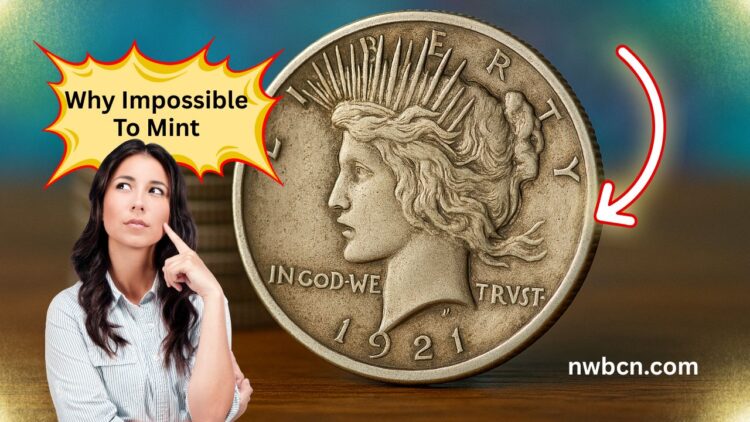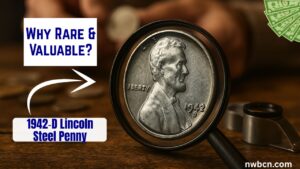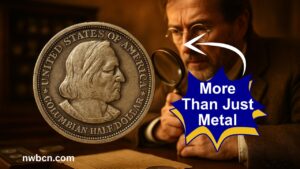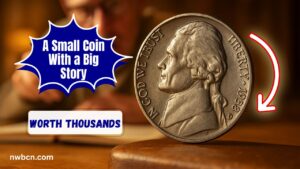In late 1921, the United States Mint introduced the Peace Dollar, designed by Anthony de Francisci, to commemorate the end of World War I. The initial striking was the only time the Peace Dollar was issued in high relief, featuring dramatically raised details far above the coin’s edge.
Although visually stunning, this first-year 1921 high-relief Peace Dollar was nearly impossible to mass-produce, making it one of the rarest and most valuable U.S. silver coins today.
Why High Relief Matters
- High relief means the image rises noticeably above the coin’s rim for sharper art.
- This style highlighted de Francisci’s striking design but led to:
- Bank stacking issues
- Rapid die wear, as dies cracked under excessive pressure
- The Mint’s quick shift to low relief versions by 1922.
Production Challenges at the Mint
| Challenge | Description |
|---|---|
| Stacking Problems | High relief coins didn’t stack well, disrupting bank operations |
| Die Breakage | Dies lasted only a few strikes—breakage occurred 3–4× more than usual |
| Time & Cost | Strikes required more pressure, slowing production |
| Rapid Design Change | By Jan 10, 1922, the design was lowered to standard relief |
The Mint struck over 1 million high-relief 1921 Peace Dollars in four days—an astonishing pace given the complexities.
Technical Specs and Design Beauty
- Composition: 90% silver, 10% copper (~0.773 oz silver)
- Diameter: 38.1 mm (same as other Peace Dollars)
- Obverse: Radiant Liberty with flowing hair
- Reverse: Bald eagle perched on rock, “PEACE” motto prominently displayed
- The high-relief struck from a single press made each coin a bold showcase of artistry.
1921 High-Relief Peace Dollar Overview
| Feature | Detail |
|---|---|
| Mint Year | 1921 |
| Relief Style | High relief (only issue year for Peace Dollars) |
| Mintage Volume | ~1,006,473 |
| Emergency Production | 4-day intensive strike |
| Production Issues | Die wear, die cracking, stacking problems |
| Low-Relief Conversion | Implemented Jan 10, 1922 |
| Legal Tender Value | $1 face; ~25× bullion value |
| Collector Value Range | VF: $200–$500; MS63: $2,000–$3,500; MS65+: $4,000+ |
| Rarity Level | Scarce in all uncirculated grades |
Rarity & Survival
Although a million were struck, many were released into circulation, melted down, or stored under poor conditions. As a result:
- High-grade coins are extremely rare, especially in Mint State (MS) conditions.
- Coins in MS64 condition are prized and often certified by PCGS/NGC.
- MS65+ specimens can command several thousand dollars.
Market Value Table
| Grade | Price Range (2025) |
|---|---|
| Very Fine (VF30) | $200–$500 |
| Extremely Fine | $700–$1,200 |
| Uncirculated (MS60–62) | $1,800–$3,500 |
| MS63–MS64 | $3,500–$6,000 |
| MS65+ | $6,000–$15,000+ |
Collectors prize pieces with sharp details, strong luster, and minimal wear.
Market Demand & Popularity
- The 1921 high-relief Peace Dollar remains the key date in the series, often called the “holy grail” of Peace dollars.
- Its first-year status, combined with the single-year high relief design, cements its collectibility.
- Auction performance has risen steadily as silver values and numismatic interest increase.
- Even mid-grade specimens now regularly exceed $2,000–$3,000.
Detecting a Genuine 1921 High-Relief Peace Dollar
- Shape of relief: Overtly raised design with deep, sharp details
- Check die cracks: Strengthened dies often left visible lines
- Inspect rim and edge: High relief often shows distinctive edge finish
- Weight verification: Should match 26.73 g with ±0.1 g accuracy
- Use grading certificates: Only certified coins (PCGS/NGC) offer true authenticity
Tips For Collectors
- Buy through reputable dealers or auction houses to avoid counterfeits
- Look for grading of MS60+ in PCGS/NGC slabs for reliable condition
- Compare strike variety: later collectors often seek especially sharp examples
- Stay mindful of market trends: prices shift with silver and interest levels
The 1921 high-relief Peace Dollar perfectly merges artistry, history, and rarity. Its dramatic design and fraught production make it one of the most sought-after silver coins. Despite over one million minted, very few have survived in pristine condition.
Today, full luster and detailed examples draw serious collector attention—and significant value. For numismatists, owning one is more than possessing silver—it’s preserving American artistry and perseverance in a fragile post-war era.
FAQs
Q1: What makes the 1921 Peace Dollar ‘high relief’?
It features sculpted details pressed high above the rim, giving dramatic depth—unlike the low-relief designs of later years.
Q2: Why did the Mint stop making high-relief versions?
High relief required excessive die pressure, causing frequent die failure and stacking issues. By 1922, the design was revised to low relief for efficiency .
Q3: How rare is a mint-state 1921 Peace Dollar today?
Mint-state coins are scarce; only a handful in grades MS63 and above exist, and high grades command thousands per piece .




